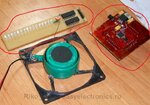osa1313
Junior Member level 3
Hi i am new to this forum and i found this youtube video. I followed the links in the description and got to this site
1. Rotating LED Globe - Hacked Gadgets – DIY Tech Blog
and also found this one
2. DIY Spinning LED Globe Build Log - Hacked Gadgets – DIY Tech Blog
and this one
3. Arduino based Rotating POV Globe - Hacked Gadgets – DIY Tech Blog
And i thought that i would like to make a similar one or just about same one like in the LINK 2 and LINK 3.
But when i translated the text in LINK 2 it wasn't very good so i tried to find some info on the LINK 1 but the schematics i didn't understand very well also the code is unavailable.
On the LINK 3 i really liked the effects but i didn't find much information or schematics.
So i found this schematics. But there is few parts missing to it like the optocoupler open (I am not sure if it's the right word for this part as i had to translate it of another site basically what i mean is to add this component so the processor knows the spinning speed of the globe)And then i would need to make a code for the globe on what i want it to display where in my case it is a globe. So maybe someone on this forum made led globe and can help me with the schematics and the code. Thank You For Help.
http://obrazki.elektroda.pl/64_1274869349.png
1. Rotating LED Globe - Hacked Gadgets – DIY Tech Blog
and also found this one
2. DIY Spinning LED Globe Build Log - Hacked Gadgets – DIY Tech Blog
and this one
3. Arduino based Rotating POV Globe - Hacked Gadgets – DIY Tech Blog
And i thought that i would like to make a similar one or just about same one like in the LINK 2 and LINK 3.
But when i translated the text in LINK 2 it wasn't very good so i tried to find some info on the LINK 1 but the schematics i didn't understand very well also the code is unavailable.
On the LINK 3 i really liked the effects but i didn't find much information or schematics.
So i found this schematics. But there is few parts missing to it like the optocoupler open (I am not sure if it's the right word for this part as i had to translate it of another site basically what i mean is to add this component so the processor knows the spinning speed of the globe)And then i would need to make a code for the globe on what i want it to display where in my case it is a globe. So maybe someone on this forum made led globe and can help me with the schematics and the code. Thank You For Help.
http://obrazki.elektroda.pl/64_1274869349.png
Last edited:

